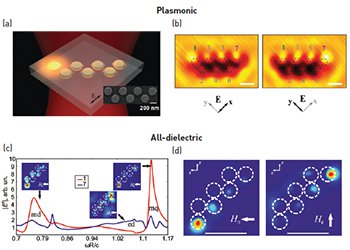 (a) Schematic of experiment in ref. 5, with SEM image of the fabricated zigzag chain of gold nanodisks (inset). (b) Near-field map measured for two orthogonal polarizations of incident light, showing “hot spots” at chain edges. (c) Spectral dependence of electric-field intensity near the first and last dielectric spheres (ref. 4); insets correspond to electric field at the different resonances of the single particle. (d) Experimental near-field maps of edge states excited in chain of dielectric particles.
(a) Schematic of experiment in ref. 5, with SEM image of the fabricated zigzag chain of gold nanodisks (inset). (b) Near-field map measured for two orthogonal polarizations of incident light, showing “hot spots” at chain edges. (c) Spectral dependence of electric-field intensity near the first and last dielectric spheres (ref. 4); insets correspond to electric field at the different resonances of the single particle. (d) Experimental near-field maps of edge states excited in chain of dielectric particles.
The discovery of topological insulators in condensed-matter physics has triggered a pursuit for analogous states in light.1 In solids, topological insulators don't conduct bulk current, but possess conducting surfaces due to topologically protected edge states,2 which can carry current without dissipation even in the presence of impurities. Several sophisticated designs have been developed for topological photonics, and unidirectional photon transport has been predicted and demonstrated.1
In previous work, we proposed an approach for realizing subwavelength topological states at the nanoscale.3 We revealed that hybridization of the polarization-degenerate modes of a zigzag chain of plasmonic nanoparticles engenders the chiral-symmetric energy spectrum. The structure exhibits a topological transition when the chain changes from a line to a zigzag—the straight-chain spectrum is topologically trivial, with a vanishing parity of the winding number P. For the zigzag chain this Z2 topological invariant is nonzero, which is a hallmark of edge states at both chain edges.3,4
A recent experiment has now confirmed the presence of edge states in the zigzag chain of gold nanodisks in the visible.5 The chain was excited from the substrate side, and near-field patterns of the plasmonic modes induced in the structure were mapped by a near-field scanning optical microscope. The near field has “hot spots” at the chain edges that can be switched by rotating the incident light polarization.
We subsequently generalized our theory to a broader class of electromagnetic structures including dielectric nanoparticles with different symmetries of the coupled optical modes.4 We observed subwavelength topological edge states for electric and magnetic dipole and magnetic quadrupole modes. Moreover, we demonstrated directly the robustness of the edge states against disorder. These results open novel avenues to engineer topological states of light at the nanoscale.
Researchers
Alexey Slobozhanyuk and Yuri Kivshar, Australian National University, Canberra, Australia, and ITMO University, St. Petersburg, Russia
Alexander Poddubny, ITMO University and Ioffe Physical-Technical Institute, St. Petersburg, Russia
Andrey Miroshnichenko, Australian National University
Ivan Sinev, Ivan Mukhin and Anton Samusev, ITMO University
References and Resources
1. L. Lu et al. Nat. Photon. 8, 821 (2014).
2. M.Z. Hasan et al. Rev. Mod. Phys. 82, 3045 (2010).
3. A.N. Poddubny et al. ACS Photon. 1, 101 (2014).
4. A.P. Slobozhanyuk et al. Phys. Rev. Lett. 114, 123901 (2015).
5. I.S. Sinev et al. Nanoscale 7, 11904 (2015).
